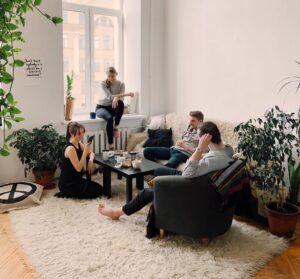As lockdown restrictions ease across Europe, governments are considering just how much and how widely they should advise citizens to socialise with people outside their own household.
The idea is that everyone interacts within a small group of people to prevent COVID-19 from spreading further. For example, as of 10 May, the Belgian government allows people to form social bubbles of up to four people. These people aren’t allowed to visit anywhere else. However, it’s a fine line between maintaining mental health after several weeks of COVID-19-related lockdowns and keeping transmission rates as low as possible.
A group affair
According to a study led by Oxford University sociologists, altering the way our social networks are organised instead of simply decreasing how much we socialise could help flatten the curve. “There must be a middle ground between all of us staying at home and all of us meeting the people we want in the ways we want to,” lead author Per Block and sociologist at Oxford told ‘CNN’. “Our main aim here is to give people guidance on how they can structure their social surroundings so that hopefully in a year’s time we are there, and not that people at some point just give up completely on social distancing, and that we are back in a second wave by the end of the year and have to start this whole staying at home business all over again.”
Social bubble
Who to include in the bubble can get complicated in terms of age. “Families, for example, span across huge age ranges; and there are potential side effects like huge psychological and social damages if we try and segregate,” Block told ‘Euronews’.
Interacting with others from the same area or forming new networks with neighbours could be effective.
“If we restrict our interactions geographically – such as two blocks from our home – we create barriers between long-distance contact. If we restrict our interactions to something very local like this, it would take, say, five to seven steps of transmissions before someone ten blocks away becomes infected. It slows down the rate that the infection reaches someone else.”
Block says that for social bubbles to work, everyone must fully cooperate. “If we want to have a social bubble of ten, then all ten people need to stick to it. We need a sense of solidarity; we need to stick together; we all need to work jointly together.”
Some experts have their doubts. “I think we need to look at the data and let science guide us before we start making recommendations about socialization,” Dr Krutika Kuppalli, an infectious diseases physician and biosecurity fellow at the Johns Hopkins Center for Health Security in the United States, told ‘CNN’. Moreover, William Hanage, an associate professor of epidemiology at the Harvard School of Public Health, said “There are multiple reasons to be cautious, from the obvious fact that some people will be more at risk, for example, the elderly, and should not participate, to the fact that some people may be more at risk of already being infected themselves, people working in health care for instance.”







Leave a Reply